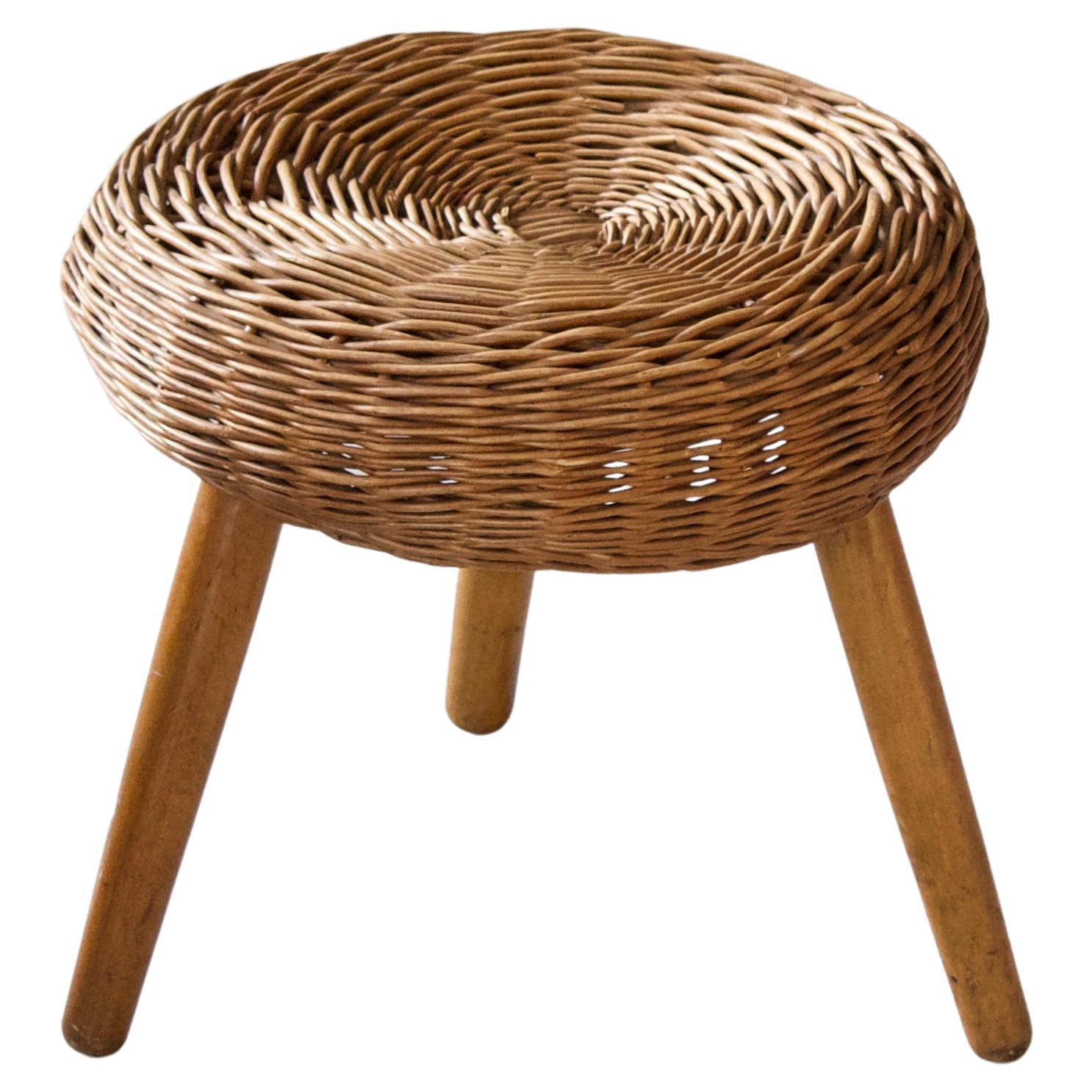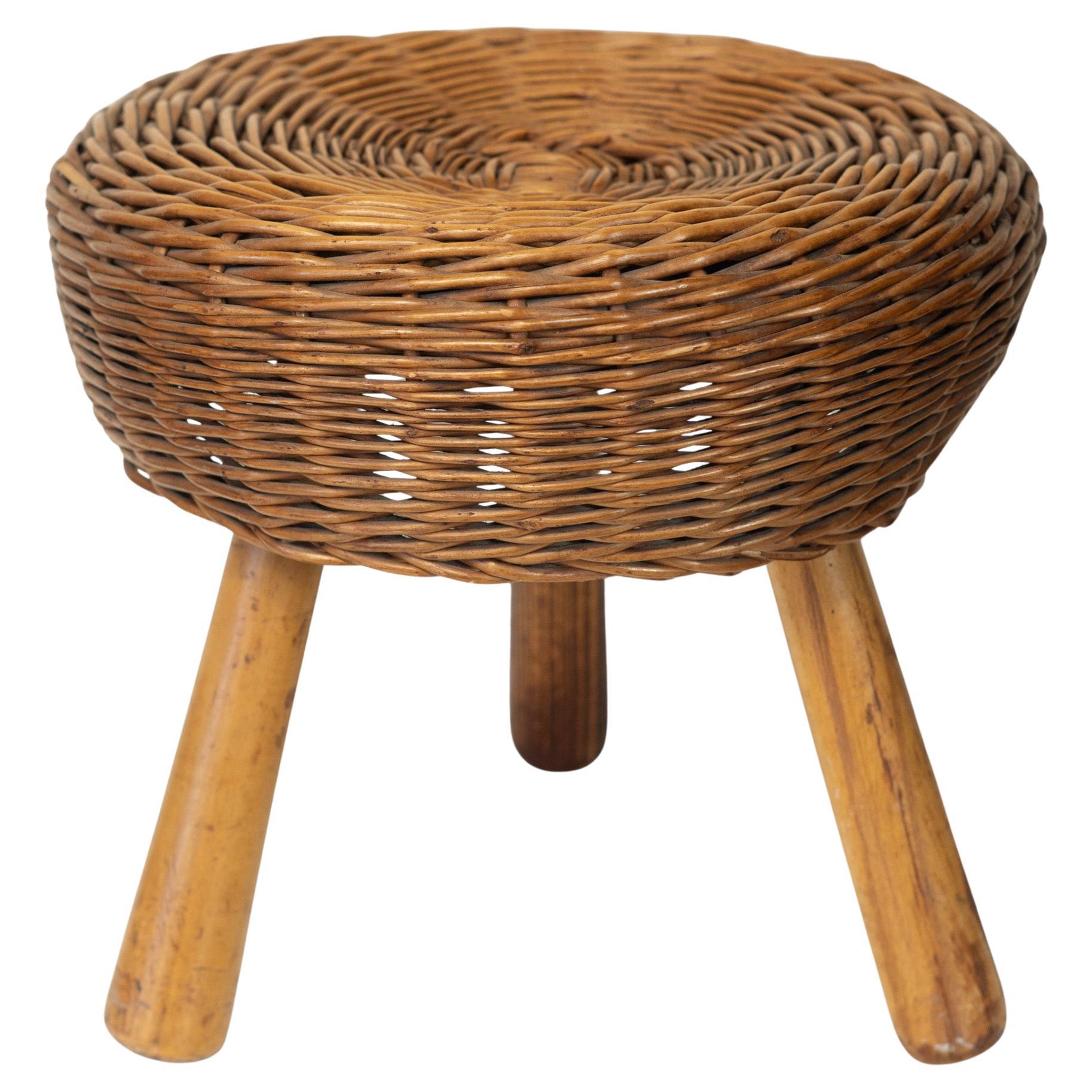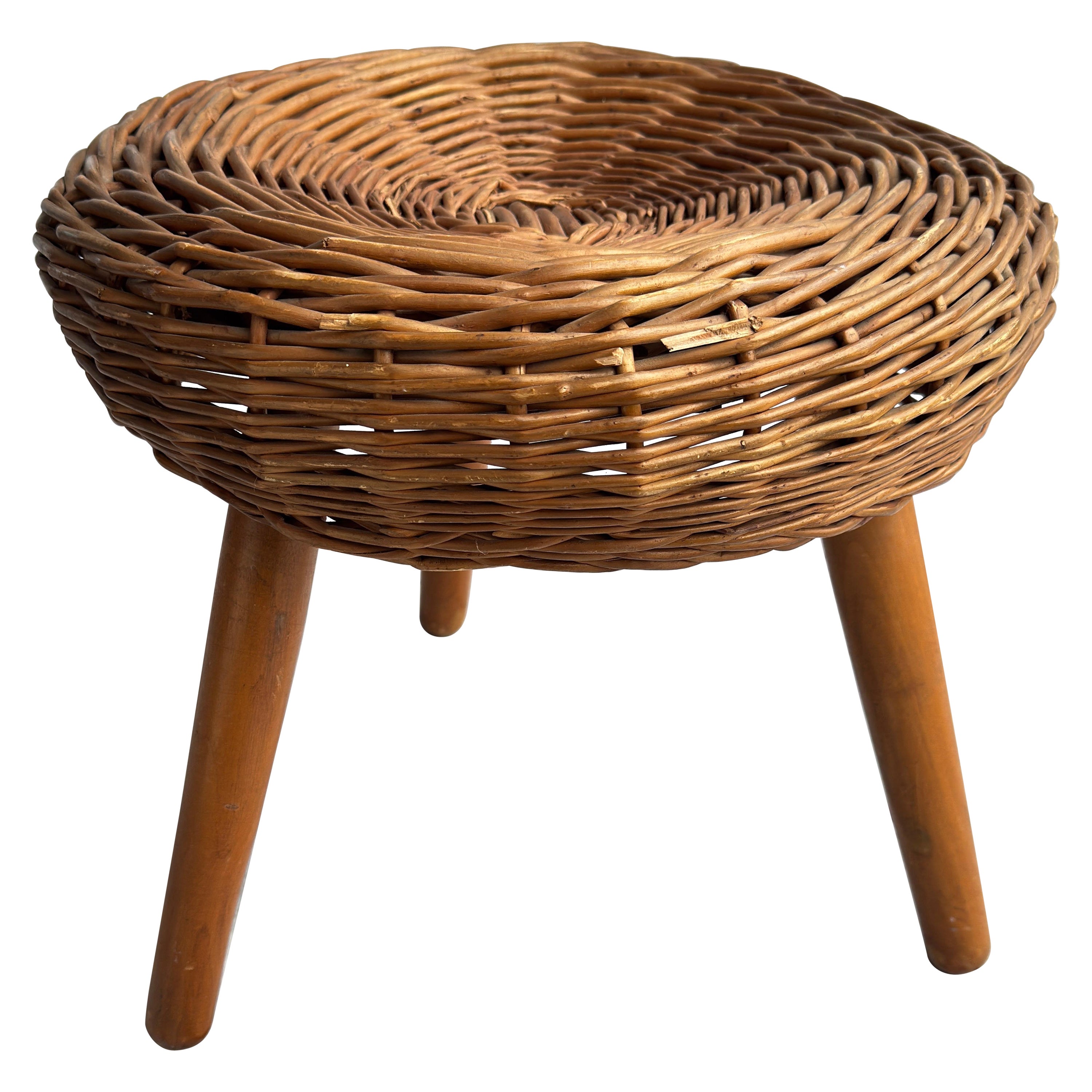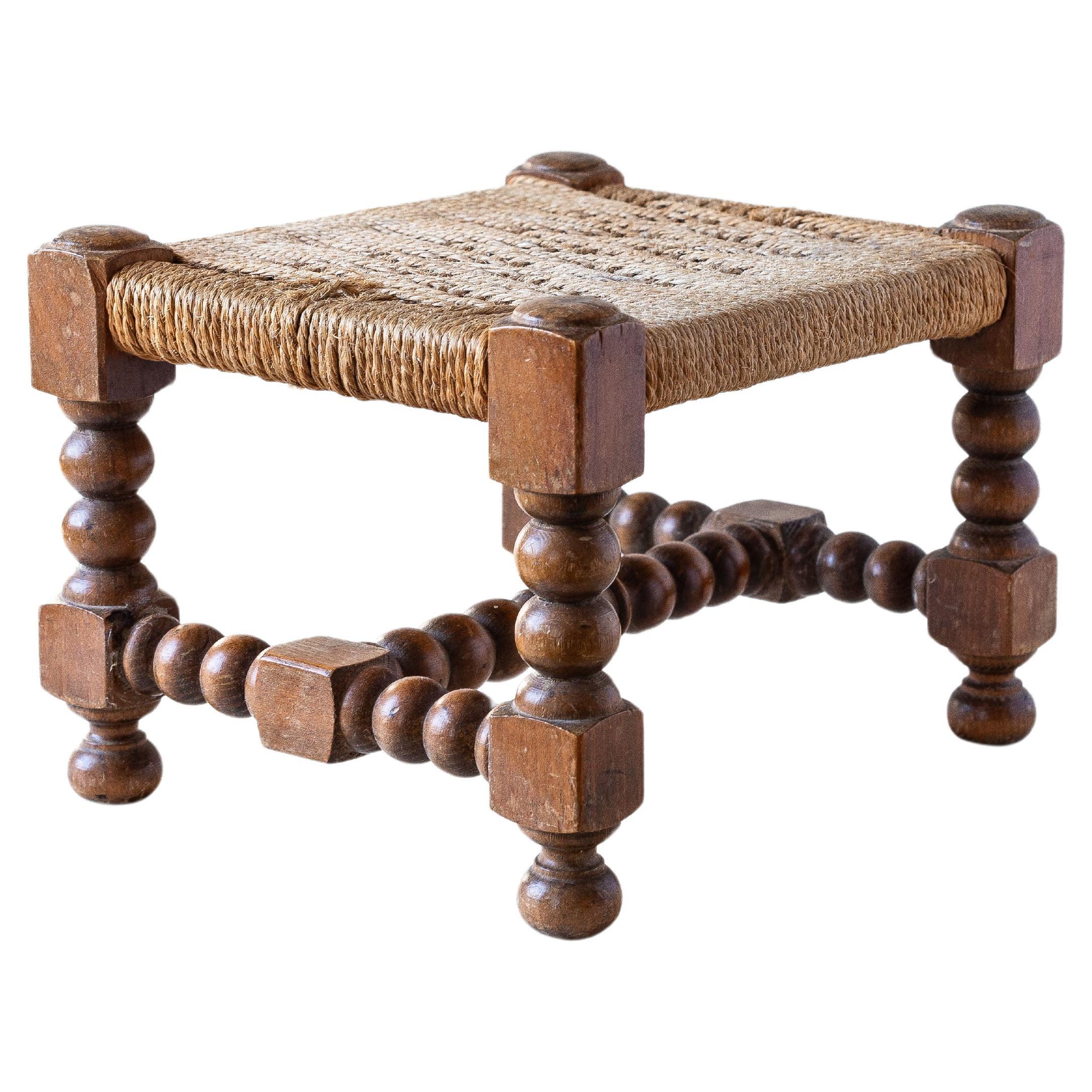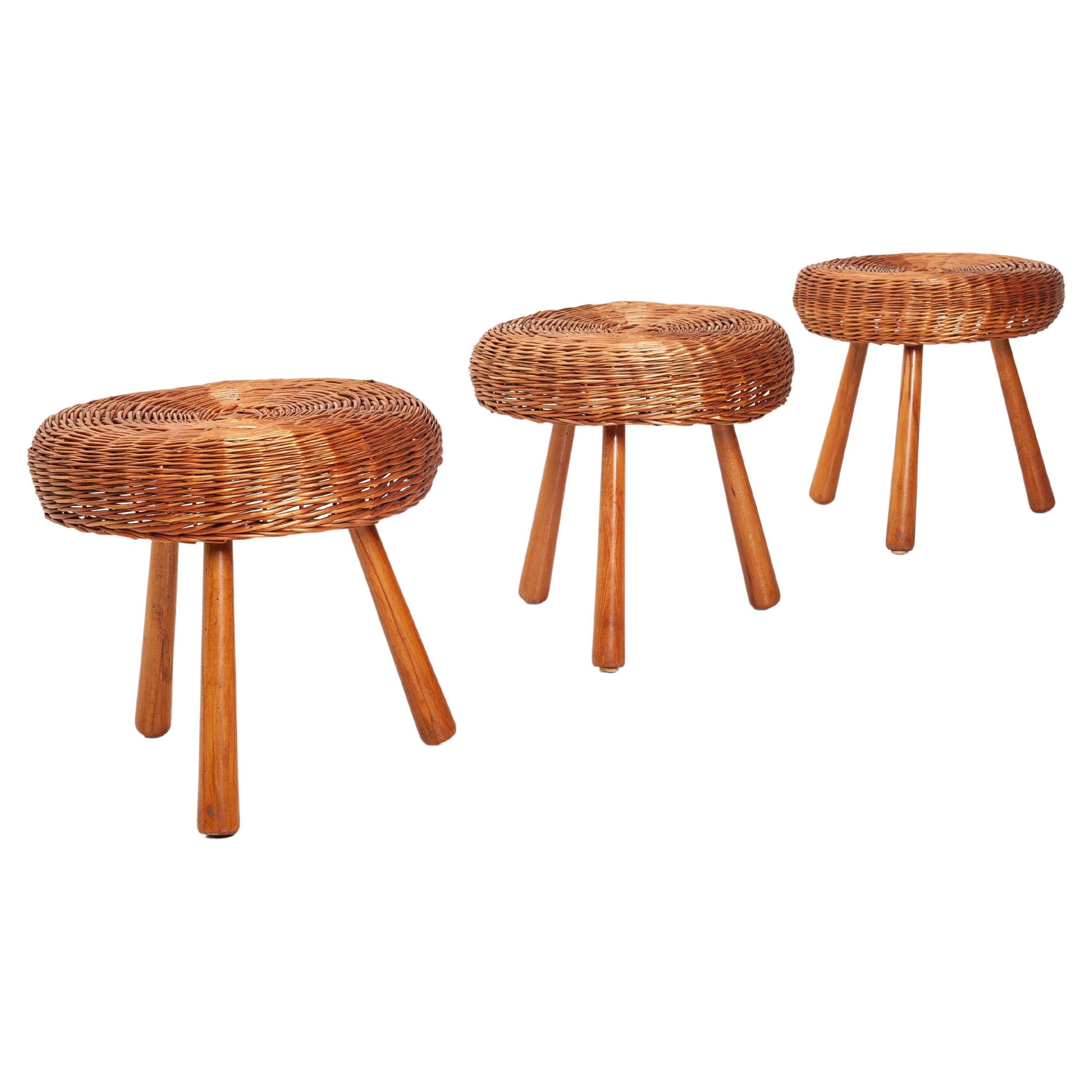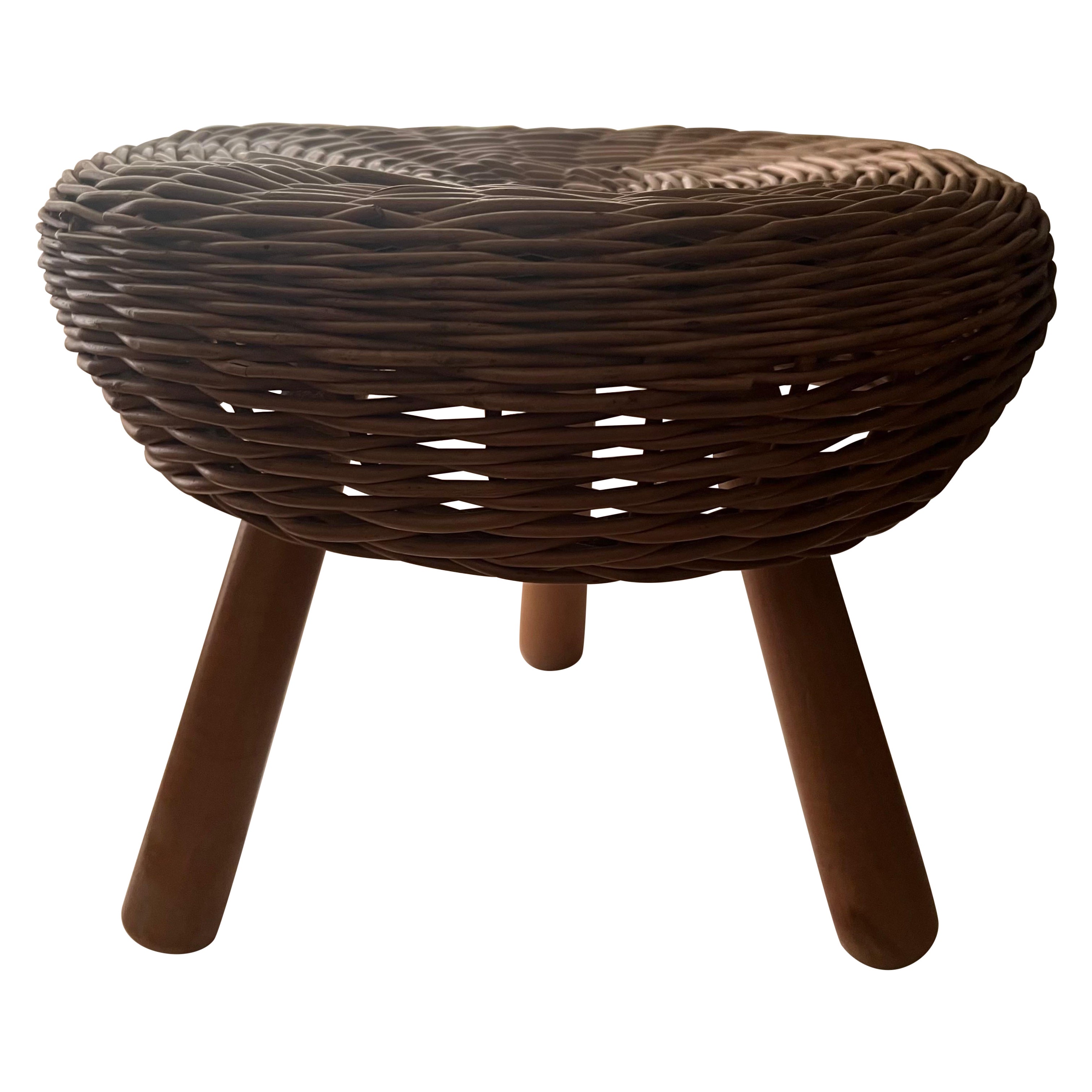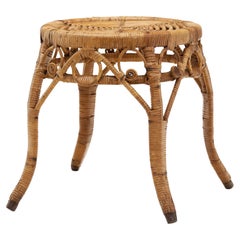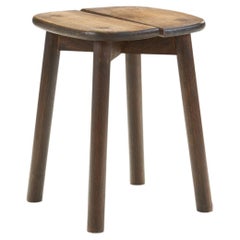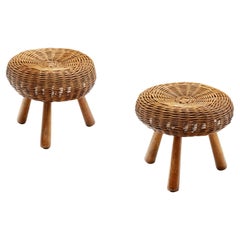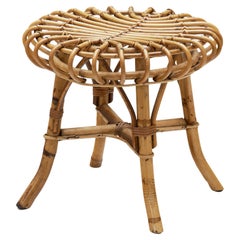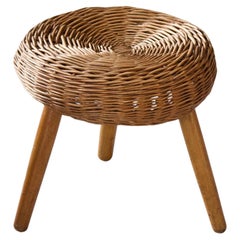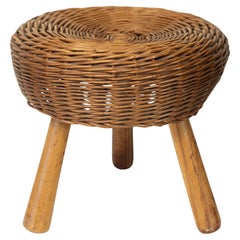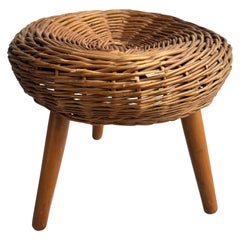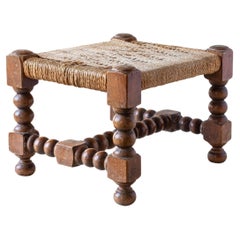Items Similar to Woven Rush and Wood Stool, Europe ca 1950s
Want more images or videos?
Request additional images or videos from the seller
1 of 14
Woven Rush and Wood Stool, Europe ca 1950s
$990
£755.86
€873.39
CA$1,389.77
A$1,549.05
CHF 812.73
MX$18,916.38
NOK 10,290.95
SEK 9,726.51
DKK 6,518.49
About the Item
From Charlotte Perriand to Axel Einar Hjorth, stools have been staples in European design history. Modernist stools, like this organic model, stem from one of the earliest forms of seating, the milking stool. With a highly functional history and modernist look, this stool is a rare and stylish piece.
The design is characteristically simple in its form with clean lines, organic materials, and robust legs. Like many of its Scandinavian contemporaries, this stool maker favoured the use of high-quality, beautifully grained wood and rush. This solid wood and rope stool stands out thanks to its seat, made of expertly woven rush. Stretched between the wooden frame, the seat’s texture and colour pairs beautifully with the wood. The rush weaving is exceptionally crisp, showcasing the layered pattern and the weaver’s skill equally. Furthermore, the seat has a subtle ergonomic shape thanks to the rush’s natural qualities to accommodate the sitter. The four, robust wooden legs are hand carved into their peculiar shape where only the outer side touches the floor, lifting the design up to create a light, effortless impression. Every functional part, including the thick legs, serve an aesthetic purpose as well. The lines are rounded out and complement the visually arresting pattern of the wood and the woven seat. The core principle of modernist design emphasizes that one should be in harmony with his or her environment, which therefore needs to be free of anything unnecessary. In line with this sentiment, this stool entirely focuses on its solid wood and rush material and well-crafted, hand woven seat.
Characterized by functionality, simplicity and clean lines, the design of this stool is all about harmony. Its organic charm is palpable and exudes a lot of charm. This model is the perfect piece to add some modern organic charm to any interior. The expertly woven rush seat and overall quality and craftsmanship guarantee longevity to this heirloom piece.
Condition:
In good vintage condition. Wear consistent with age and use. Some small scratches and marks on the patinated wood.
Dimensions:
13.58 in W x 9.64 in D x 4.52 in H
34.5 cm W x 24.5 cm D x 11.5 cm H
- Dimensions:Height: 4.53 in (11.5 cm)Width: 13.59 in (34.5 cm)Depth: 9.65 in (24.5 cm)
- Style:Mid-Century Modern (Of the Period)
- Materials and Techniques:
- Place of Origin:
- Period:
- Date of Manufacture:ca 1950s
- Condition:Wear consistent with age and use. Some small scratches and marks on the patinated wood.
- Seller Location:Utrecht, NL
- Reference Number:Seller: 202320781stDibs: LU2947337500072
About the Seller
5.0
Recognized Seller
These prestigious sellers are industry leaders and represent the highest echelon for item quality and design.
Platinum Seller
Premium sellers with a 4.7+ rating and 24-hour response times
1stDibs seller since 2017
523 sales on 1stDibs
Typical response time: 5 hours
Associations
20th Century Specialists
- ShippingRetrieving quote...Shipping from: Utrecht, Netherlands
- Return Policy
Authenticity Guarantee
In the unlikely event there’s an issue with an item’s authenticity, contact us within 1 year for a full refund. DetailsMoney-Back Guarantee
If your item is not as described, is damaged in transit, or does not arrive, contact us within 7 days for a full refund. Details24-Hour Cancellation
You have a 24-hour grace period in which to reconsider your purchase, with no questions asked.Vetted Professional Sellers
Our world-class sellers must adhere to strict standards for service and quality, maintaining the integrity of our listings.Price-Match Guarantee
If you find that a seller listed the same item for a lower price elsewhere, we’ll match it.Trusted Global Delivery
Our best-in-class carrier network provides specialized shipping options worldwide, including custom delivery.More From This Seller
View AllWoven Rattan Stool, Europe Early 20th Century
Located in Utrecht, NL
In the professional field of interior design, certain pieces and types of furniture hold a timeless allure, effortlessly weaving together functionality, aesthetic appeal, and a rich history. Among these treasures is the simple, way too often overlooked, but extremely versatile stool,
This lovely piece from the early 20th century is entirely Crafted from the organic material rattan, and embodies a harmonious blend of natural beauty, craftsmanship, and functional elegance, making it a perfect accent piece for both modern and classic interior settings.
Rattan, derived from the climbing palms native to tropical regions of Africa, Asia, and Australasia, boasts a unique combination of flexibility, durability, and lightweight properties. As such, its pliable nature allows skilled artisans to deftly manipulate and weave it into intricate patterns, resulting in furniture pieces like this stool that exude both sophistication and an artisan, rustic charm. Similarly to traditional wooden furniture, rattan possesses a warmth and tactile quality that invites touch and appreciation of its natural texture.
The resurgence of stools in contemporary interior design can be attributed to several factors; Firstly, their compact size and versatility make them ideal for maximizing space in smaller living areas or apartments. Stools can easily be tucked away when not in use, serving as convenient additional seating when guests arrive or as a practical surface for holding books, plants, or decorative items. Moreover, their understated elegance, individuality, and timeless appeal complement a wide range of interior styles, from minimalist and Scandinavian to Bohemian and eclectic.
At the heart of this rattan stool's charm lies its exquisite weaving patterns and impeccable quality. Each strand of rattan is skilfully interlaced to form intricate circular motifs and geometric designs, showcasing the craftsmanship and attention to detail of its maker. The weaving technique employed in crafting this stool results in a sturdy yet lightweight structure, capable of withstanding the test of time while retaining its graceful silhouette.
The stool's slightly splayed, bent legs add a touch of visual interest and stability, while the metal caps on its feet provide both protection and a subtle hint of industrial flair. This thoughtful combination of materials and design elements enhances the stool's durability and aesthetic appeal, ensuring that it remains a cherished heirloom for generations to come.
Versatile in its functionality, the rattan stool can serve as a humble pallet for showcasing curated collections or as an elegant flower pedestal, bringing a touch of natural beauty indoors. Its timeless allure and understated sophistication make it a beloved accent piece in modern interiors, where it serves as a testament to the enduring appeal of organic materials and masterful craftsmanship.
In conclusion, the intricately woven rattan stool...
Category
Early 20th Century European Mid-Century Modern Stools
Materials
Rattan
Mid-Century Wooden Stool with Split Seat, Europe Ca 1950s
Located in Utrecht, NL
Stools have been steadily increasing in popularity thanks to a number of reasons, the most obvious being their space-saving functionality. Stools can be used in any space to provide an easily moved alternative to more cumbersome furniture. However, thanks to their versatility, they can provide a lot of visual interest.
European mid-century design is generally characterized by a minimal, clean approach that seeks to combine functionality with beauty. With its focus is on simple lines and light spaces, this stool is devoid of clutter. Standing on four straight legs, the sole decorative element is the split seat...
Category
Vintage 1950s European Mid-Century Modern Stools
Materials
Wood
A Pair of Wicker Stools by Tony Paul, United States 1950s
By Tony Paul
Located in Utrecht, NL
Form and function collide with these stools, a piece of furniture that is often underestimated. Designers define stools as jewels and statements in a space, and taking practicality i...
Category
Vintage 1950s American Mid-Century Modern Stools
Materials
Rattan, Wood
Bamboo and Rattan Stool by Franco Albini (Attr.), Italy 1960s
By Franco Albini
Located in Utrecht, NL
Franco Albini’s best known designs were made of natural materials, especially rattan and bamboo, numerous of which belong to the permanent collections of museums, such as New York’s ...
Category
Vintage 1960s Italian Mid-Century Modern Stools
Materials
Bamboo, Rattan
Stool with Upholstered Seat by La Compagnie des Arts Français, France 1940s
By Compagnie Des Arts Français
Located in Utrecht, NL
Founded in the early 20th century and led during its most influential years by designers like Jacques Adnet, La Compagnie des Arts Français took part in shaping modern French interio...
Category
Vintage 1940s French Mid-Century Modern Stools
Materials
Wood, Fabric
Ethiopian-Style Stool with Scrolled Legs, Norway, First Half of the 20th Century
Located in Utrecht, NL
E?thiopian and other African-influenced furniture had been made in Europe from the 1850s, the most famous being Adolf Loos’s “Theban stool” designed aroun...
Category
Early 20th Century Norwegian Brutalist Stools
Materials
Wood
You May Also Like
Tony Paul 'Attribution' Stool, Woven Wicker, Wood, United States, 1950s
By Tony Paul
Located in High Point, NC
A stool, design attributed to Tony Paul. Features an interesting mix of rattan and finely carved solid wood.
Other designers of Minimalist stools of the period include Charlotte P...
Category
Vintage 1950s American Mid-Century Modern Stools
Materials
Wicker, Rattan, Wood
Tony Paul Woven Wicker & Wood Tri-Leg Stool, USA, 1950s
By Tony Paul
Located in Philadelphia, PA
Designed and made in the USA by Tony Paul, this stools features a hand-woven wicker seat set on a wood base with three turned wood legs. Often simply attributed to Paul, mine is auth...
Category
Vintage 1950s American Mid-Century Modern Stools
Materials
Wicker, Wood
1950s Tony Paul Wood and Wicker Foot Stool Plant Stand Ottoman
By Tony Paul
Located in Cordova, SC
Wood and wicker foot stool attributed to Tony Paul. Circa 1950s. The top of the stool is somewhat concaved, but this does not affect the integrity of the piece. It’s very comfortable...
Category
Vintage 1950s American Mid-Century Modern Footstools
Materials
Wicker, Wood
$1,000 Sale Price
20% Off
Brutalist Low Stool in Woven Rope on Wood France 1960s
By Charles Dudouyt, Adrien Audoux and Frida Minnet
Located in ROUEN, Normandie
Brutalist Low Stool in Woven Rope on Wood France 1960s
Beautifully carved low stool in solid wood with woven cording seat.
The cord is made of jute and is woven with a geometric zi...
Category
Mid-20th Century French Mid-Century Modern Stools
Materials
Jute, Cord, Rope, Wood, Fruitwood
$610 Sale Price
30% Off
Tony Paul Attributed Stools, Woven Wicker, Solid Beech, United States, 1950s
By Tony Paul
Located in Chiavari, Liguria
Set of three stools with a handwoven wicker top and solid beech legs attributed to the famous American designer Tony Paul.
Produced in the late 1950s these stools are in their ori...
Category
Vintage 1950s American Mid-Century Modern Stools
Materials
Wicker, Beech
1950s attributed to Tony Paul Woven Stool with threaded wooden removable legs
By Tony Paul
Located in Pineville, NC
For your consideration, we are offering this lovely vintage 1950s woven stool by Tony Paul. This Iconic Design has a warm patina. The tapered wooden dowel legs with threaded tops s...
Category
Vintage 1950s American Stools
Materials
Reed
More Ways To Browse
Bertoia Counter Stool
Cappellini Bar Stool
Champagne Cork Stool
Charlotte Perriand Sandoz Stool
Charlotte Perriand Sandoz
Chinese Garden Stools Famille Rose
Chinese Lacquered Garden Stools
Cleo Baldon Style
Cosco Retro Furniture
Counter Stool Fox By Woo
Crocodile Stool
Duet Piano Stool
Egyptian Folding Stool
Emeco Counter Stools
Frederick Weinberg Bar Stools
Frog Stool
Giorgina Castiglioni
Gold Hill Stool
